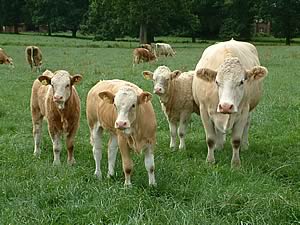 |
|||||||||
|
|||||||||||||||||||||||||||||
|
|
Boosting Suckled Calf Values with Better Fertility English beef producers could boost suckled calf values by more than £20/head in the coming season at little or no extra cost by improving herd fertility, according to the latest advice from the English Beef and Lamb Executive (EBLEX).
As well as cutting the annual cost of herd replacements, better fertility ensures a compact calving period which, in turn, increases average suckled calf weights at weaning and improves both feed and labour efficiency. Some 75% of cows currently hold to first service in the best recorded herds. This means 98% calve within a 9 week period so that, at weaning, when the oldest calves are 210 days of age the entire crop will average 205 days. In contrast, the 40% first service pregnancy rate of the worst fertility herds means a 24-week calving period and average age at weaning of 182 days. With a birth weight of 45kg and 1.0 kg daily liveweight gain, this represents an average weaning weight difference of 23kg - worth £23/head at a sale price of £1/kg. At the same time, of course, more compact calving means simpler and less costly calf management. Suckler Herd Fertility & Average Weaning Weight
* Assuming 45 kg birth weight and 1.0 kg/day liveweight gain Under these circumstances, the latest EBLEX Beef Action for Profit factsheet ( available free of charge at www.eblex.org.uk ) suggests producers aim for first breeding cycle pregnancy rates of at least 65% to calve over 90% of their herd within a 10-week period. Amongst other management guidelines, the Better Returns from Higher Herd Fertility factsheet recommends:
|
||||||||||||||||||||||||||||

|
|
||||||||||||||||||||||||||||
| home | agri-services | pedigree
pen | news | dairy | beef | machinery property | organisations | site map |
|||||||||||||||||||||||||||||

